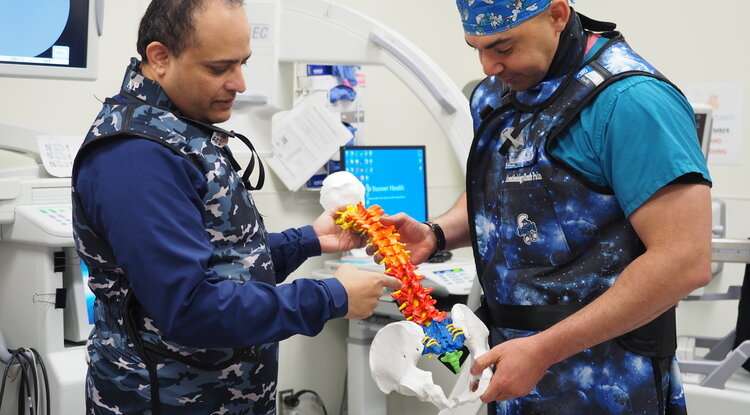Drs. Amol Patwardhan and Mohab Ibrahim point out the most frequent places of back chronic pain on a model of the human spine. Credit: Flavie Audoin
Chronic non-cancer pain is sometimes managed with high-dose opioids, which has partially contributed to the current opioid epidemic. New research from pain specialists at the University of Arizona and Banner – University Medicine may provide options other than opioids for patients with non-cancer chronic pain.
"Our study shows the possible potential of pain clinics in helping to reduce opioid use while improving pain and function in patients on opioids suffering from non-cancer chronic pain," said senior author Dr. Mohab Ibrahim, director of the Chronic Pain Management Clinic at Banner – University Medical Center South and an associate professor in the UA departments of anesthesiology and pharmacology.
The study evaluated the role of a pain management clinic with fellowship-trained pain physicians in reducing pain and opioid use in patients with chronic non-cancer pain.
Patients were asked to rate their pain on a scale of zero to 10, with results showing the average pain score decreased by almost 34 percent. The pain frequency and number of pain episodes improved. Also, the patients reported better ability to sleep, work and perform chores. Finally, the patients were able to reduce their total opioid use by about 55 percent.
The findings were published Nov. 30 in the journal Pain Physician.
In the United States, as much as $300 billion is spent each year to manage pain. Chronic pain affects 100 million Americans – more than than diabetes, heart disease and cancer combined, according to the American Academy of Pain Medicine.
Doctors at pain clinics help patients manage chronic pain and improve their quality of life using not only medications and interventional procedures, but also modalities such as physical, behavioral and psychological therapies.
"Generally speaking, our pain clinic focuses on offering all available options to get people to decrease their opioids or get them off their opioids altogether," Ibrahim said. "Those include physical therapy, acupuncture, yoga, chiropractors, tai-chi, non-opioid medications, interventional procedures, and sometimes seeking help from our surgical collogues with whom we have excellent and close collaborations."
Tucson has about 15 pain management clinics, including the Comprehensive Pain Management Clinic. Ibrahim's study was retrospective and used pain data from 296 patients treated at the clinic between July 2014 and January 2016.
During clinic visits, patients filled out a form asking about changes in the intensity, frequency and duration of their pain, and their ability to fall and stay asleep, work, exercise and perform chores. The team also analyzed patients' initial opioid use and their opioid use at the most recent visit.
The most common types of chronic pain were: headaches, migraines, neuropathic pain, arthritic pain and abdominal pain. All of the patients were treated with conventional pain-management approaches, ranging from physical therapy to medical non-opioid management to interventional procedures, depending on the patients' needs and the clinical scenario. For example, if a patient was in severe pain, then physical therapy may not be the best first option, since he or she may not be able to actively participate in physical therapy.
Ibrahim and his co-authors – lead author Dr. Amol Patwardhan, Dr. Ryan Matika, Dr. Janalee Gordon, Brian Singer and Dr. Michelle Salloum – were able to demonstrate they could decrease pain and opioids at the same time, while maintaining patient satisfaction and improving their functionality. As Ibrahim said, that is really the whole purpose of pain medicine – to improve the functionality of the patients and decrease their reliance on medications.
"We were able to decrease the pain by about 30 to 40 percent while decreasing opioid use by 50 percent," Ibrahim said.
From 1999 to 2013, prescriptions for opioid painkillers quadrupled, as did opioid-related deaths in the United States. In 2013, an estimated 2 million Americans misused or abused prescription opioids, according to a paper published in BioMed Central in May 2018.
Ibrahim said opioids can cause a vicious circle because once a patients' pain is no longer controlled, physicians may increase the dosage and the patient will feel better for a while; then, the pain gets worse. This can get to the point where the patient is on such a high dose of opioids it becomes unmanageable – and that is when things can go wrong. However, Ibrahim said he does not want to generalize because some patients' pain is very well controlled with opioids.
"You can use a hammer to drive a nail through a wall and that's a good function of the hammer; you are using the tool in the right way. But if someone else with bad intentions gets that hammer and breaks someone's windshield, that's a bad use of the tool. It does not mean that the hammer is good or bad, it is just whether the person who used it had good or bad understanding of its function. Same thing with drugs," Ibrahim explained.
As the authors state, finding nonopioid solutions to treat chronic pain is a work in progress. Much potential exists for future research in pain clinics throughout Arizona and the U.S.
"Pain is better controlled when you approach it from several angles, not just one," Ibrahim said.
More information: Exploring the Role of Chronic Pain Clinics: Potential for Opioid Reduction. Pain Physician. 2018 Nov. www.painphysicianjournal.com/c … t/pdf?article=NTUxMA%3D%3D&journal=114
Journal information: BioMed Central
Provided by University of Arizona






















